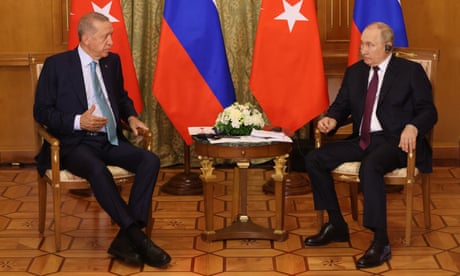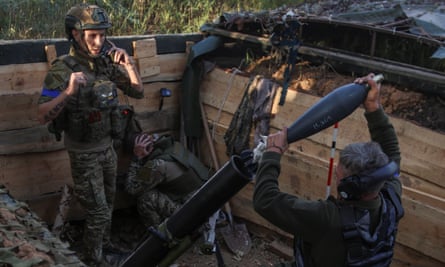Guardian:
Ukraine’s slow progress piles pressure on west to keep up supply of weapons
Kyiv’s counteroffensive slog means war is far from over – and Moscow still has chance of succeeding in its revised aims
Tue 5 Sep 2023 21.37 AEST

Ukraine’s declaration that it has breached the first of Russia’s defensive lines, towards the village of Verbove, on the critical southern Zaporizhzhia front, might give rise to hopes that, after three months of counteroffensive slog, it will be possible for Kyiv’s forces to make faster progress in expelling the Russian invaders.
In reality, it would be unwise to be too optimistic – or too pessimistic. Steadily clearing through the mine belt ahead of the first Russian fortifications is a significant achievement: the defenders have laid up to four to five mines a square metre in some places, Ukraine’s military says, a mixture of anti-tank and anti-personnel mines, sometimes stacking anti-tank mines on top of each other to ensure the destruction of any mine sweeping equipment brought forward.

Jack Watling and Nick Reynolds, in a new paper from the Rusi thinktank, estimate that Ukraine has been making “approximately 700–1,200 metres of progress every five days”, taking care to spare lives and western equipment. But there are, Watling adds, second and third Russian lines, defensive positions estimated at 20 miles deep. Moscow’s defenders are also laying further mines, sometimes with the help of drones, whose density may be less certain, but whose threat is significant enough.
Clearing the mines is dangerous work. In practice, the effort is largely conducted by specialist infantry military engineers at night, who are vulnerable to artillery if they are discovered by Russian drones or otherwise spotted. The terrain is open, with flat fields marked by tree lines and punctuated by occasional villages. Although Ukraine wants more specialist mine clearing equipment from the west, it is not clear this will come through fast enough or be effective enough.
Nor does a breach in the line amount to a breakthrough. That, Watling says, is the creation of a corridor sufficiently wide – perhaps about 6 miles – through which it is possible to safely bring forward artillery and tanks in large enough numbers to threaten areas farther south. Tokmak, a key junction town 15 miles to the south, is not yet in artillery range, although there have been reports that the Russian administrators have been quitting the settlement.

Ukrainian service members fire a mortar toward Russian troops at their position near a frontline in the Zaporizhzhia region. Photograph: Oleksandr Ratushniak/Reuters
The distances covered illustrate the difficulty faced by Ukraine so far. Since 5 June, when the counteroffensive began, at the two key points on the southern Zaporizhzhia front, Kyiv’s forces have gained about 5 miles south of Orikhiv and 7 miles south of Velyka Novosilka. The problem is that Melitopol, the ultimate target south of Orikihiv, is still 55 miles from the tip of Ukraine’s forces; and the port of Berdiansk is 70 miles from the Velyka Novosilka advance.
So gradual was the advance in July and August that it was beginning to present Ukraine with a strategic problem. Vladimir Putin may have failed in his original effort to capture Kyiv and so subjugate Ukraine but he still has a chance of succeeding in what appear to be revised war aims: to seize and hold a large chunk of Ukrainian territory, exhausting Ukraine and wearing the patience of its western backers, until perhaps Donald Trump is elected to the White House.
Nor is Russia simply in defensive mode. Its forces launched their own artillery-led counteroffensive in the Kupiansk to Lyman sector, towards the north of the eastern front in early August, out-shelling Ukraine four to one, according to Ukraine’s eastern command and even briefly shifted the frontline about two miles forward and prompted Kyiv to announce a local evacuation of civilians.
That forced Ukraine to make some hasty reinforcements, and for now it appears to be holding the line. Nor has the Russian counter to the counterattack stopped Ukraine from continuing its advance on the southern front, which has progressed marginally more quickly recently, following what appears to have been a strategic reset in the middle of August amid complaints from the US that Kyiv appeared to be trying to press on too many axes, not just in the south, but around Bakhmut in the east.
It has been clear for some time that the war is going to last well into 2024: Ukrainian military sources estimate they have until roughly the beginning of November before heavy autumn rains make further advances difficult. They also fear that Russia has been conserving some of its missiles for another attempt to knock out its energy grid in the winter; while at the same time Moscow, too, is seeking fresh arms, notably shells and missiles from North Korea.
A particular challenge, however, has been to match western support with Ukrainian battlefield needs. Kyiv has lobbied hard for western tanks and more recently F-16s, although it has not yet been able to deploy tanks to manoeuvre around its opponents, while the arrival of F-16s from, most likely early next year, might only make a modest difference given the strength of Russia’s relatively undamaged air force.
The American analysts Michael Kofman and Rob Lee argue in a lengthy posting on War on the Rocks that Ukraine’s patient tactics to some extent have been misunderstood and that its strategy of “advance[ing] incrementally with small units played to its strengths”. Unless there is a sudden political change in Moscow (or Kyiv), the war is likely to continue as it has done, meaning that what Ukraine particularly needs from the west is what they describe as “the necessary enablers – above all, artillery ammunition”.
The distances covered illustrate the difficulty faced by Ukraine so far. Since 5 June, when the counteroffensive began, at the two key points on the southern Zaporizhzhia front, Kyiv’s forces have gained about 5 miles south of Orikhiv and 7 miles south of Velyka Novosilka. The problem is that Melitopol, the ultimate target south of Orikihiv, is still 55 miles from the tip of Ukraine’s forces; and the port of Berdiansk is 70 miles from the Velyka Novosilka advance.
So gradual was the advance in July and August that it was beginning to present Ukraine with a strategic problem. Vladimir Putin may have failed in his original effort to capture Kyiv and so subjugate Ukraine but he still has a chance of succeeding in what appear to be revised war aims: to seize and hold a large chunk of Ukrainian territory, exhausting Ukraine and wearing the patience of its western backers, until perhaps Donald Trump is elected to the White House.
Nor is Russia simply in defensive mode. Its forces launched their own artillery-led counteroffensive in the Kupiansk to Lyman sector, towards the north of the eastern front in early August, out-shelling Ukraine four to one, according to Ukraine’s eastern command and even briefly shifted the frontline about two miles forward and prompted Kyiv to announce a local evacuation of civilians.
That forced Ukraine to make some hasty reinforcements, and for now it appears to be holding the line. Nor has the Russian counter to the counterattack stopped Ukraine from continuing its advance on the southern front, which has progressed marginally more quickly recently, following what appears to have been a strategic reset in the middle of August amid complaints from the US that Kyiv appeared to be trying to press on too many axes, not just in the south, but around Bakhmut in the east.
It has been clear for some time that the war is going to last well into 2024: Ukrainian military sources estimate they have until roughly the beginning of November before heavy autumn rains make further advances difficult. They also fear that Russia has been conserving some of its missiles for another attempt to knock out its energy grid in the winter; while at the same time Moscow, too, is seeking fresh arms, notably shells and missiles from North Korea.
A particular challenge, however, has been to match western support with Ukrainian battlefield needs. Kyiv has lobbied hard for western tanks and more recently F-16s, although it has not yet been able to deploy tanks to manoeuvre around its opponents, while the arrival of F-16s from, most likely early next year, might only make a modest difference given the strength of Russia’s relatively undamaged air force.
The American analysts Michael Kofman and Rob Lee argue in a lengthy posting on War on the Rocks that Ukraine’s patient tactics to some extent have been misunderstood and that its strategy of “advance[ing] incrementally with small units played to its strengths”. Unless there is a sudden political change in Moscow (or Kyiv), the war is likely to continue as it has done, meaning that what Ukraine particularly needs from the west is what they describe as “the necessary enablers – above all, artillery ammunition”.
No comments:
Post a Comment